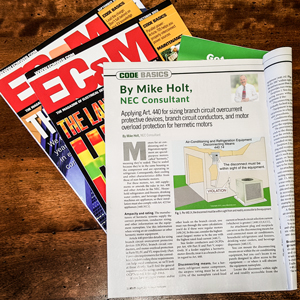
|
|
| Fire Pumps - Article 695 based on the 2014 NEC | |
|
|
|

By Mike Holt, NEC Consultant
In the NEC, the normal philosophy for circuit protection is to shut down equipment before allowing the supply conductors to overheat. Article 695 departs from this philosophy. The fire pump motor must run no matter what. The pump supplies water to a facility’s fire protection piping, which supplies water to the sprinkler system and fire hoses. Article 695 contains many requirements to ensure an uninterrupted supply of water. Some of these requirements seem wrong at first glance, until you remember why that fire pump is there in the first place. Scope Article 695 doesn’t cover: Power sources for electric motor-driven fire pumps Permitted reliable sources of power include: If reliable power can’t be obtained from a source described in 695.3(A), power must be supplied by one of the following: Exception: to 695.3(B)(1) and (B)(2): An alternate source of power isn’t required where a back-up engine-driven or back-up steam turbine-driven fire pump is installed. Transfer of power to the fire pump controller must take place within the pump room. A listed fire pump transfer switch must select the source of supply. You can’t use phase converters for fire pump service [695.3(F)]. Power continuity (A) Direct connection. The supply conductors must directly connect the power source to a listed fire pump controller, listed fire pump transfer switch, or listed combination fire pump controller and power transfer switch. (B)(1)(a) Connection through disconnecting means and overcurrent device (OCPD). A single disconnecting means and associated OCPD(s) are permitted between the fire pump power source(s) and one of the following: Overcurrent protection for individual sources must comply with 695.4(B)(2)(a)(1) or (2): (1) Individual Sources. The OCPD(s) must be selected or set to carry indefinitely the sum of the locked-rotor current of the largest fire pump motor and pressure maintenance pump motor(s), plus 100 percent of the full-load current of the other pump motors and fire pump accessory equipment. (2) Assemblies. Overcurrent protection must be provided by an assembly listed for fire pump use. The OCPD must not open: Also, the trip point for the circuit breaker must not be field adjustable. The disconnecting means for the normal power source must be [695.4(B)(3)(a)]: When an on-site generator is the alternate power source, its disconnecting means must be installed per 700.10(B)(5) for emergency circuits. It must also be capable of being locked in the closed (on) position; the provision for locking must remain in place with or without the lock installed [695.4(B)(3)(b)]. The disconnecting means must be marked “Fire Pump Disconnecting Means.” The letters must be at least 1 in. tall and visible without opening enclosure doors or covers [695.4(B)(3)(c)]. Transformers Size the primary OCPD to carry indefinitely the sum of the locked-rotor current of the fire pump motor(s) and pressure maintenance pump motor(s), plus 100 percent of the ampere rating of the fire pump accessory equipment. Secondary overcurrent protection isn’t permitted. The requirement to carry the locked-rotor currents indefinitely doesn’t apply to fire pump motor conductors [695.5(B)]. Wiring Fire pump supply conductors must [695.6(A)(2)]: When fire pump conductors are routed through a building, ensure they are one of the following [695.6(A)(2)(d)]: All wiring from the fire pump controllers to the fire pump motors must be in rigid metal conduit, intermediate metal conduit, electrical metallic tubing, liquidtight flexible metal conduit, liquidtight flexible nonmetallic conduit Type LFNC-B, listed Type MC cable with an impervious covering, or Type MI cable. The connections in the motor terminal box must be made with a listed device. Twist-on, insulation-piercing type, and soldered wire connectors aren’t allowed [695.6(D)]. Ground-fault protection of equipment isn’t permitted for fire pumps [695.6(G)]. All control wiring must be in rigid metal conduit, intermediate metal conduit, liquidtight flexible metal conduit, liquidtight flexible nonmetallic conduit Type B (LFNC-B), listed Type MC cable with an impervious covering, or Type MI cable [695.14(E)]. Conductor size Conductors supplying only a fire pump motor must have a minimum ampacity of at least 125 percent of the motor full-load current rating per 430.22 and must comply with the voltage drop requirements in 695.7 [695.6(B)(2)]. Voltage drop Running. The voltage at the load terminals of the fire pump controller must not drop more than 5 percent below the voltage rating of the motor connected to those terminals when the motor operates at 115 percent of the fire pump motor full-load current rating [695.7(B)]. Avoiding confusion
|
|||
|
|
| Visit: Exam Preparation | Continuing Education | Code Products | Newsletters | and more | |||
|
|||
|
